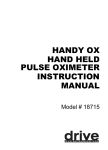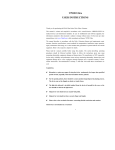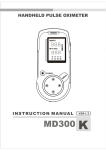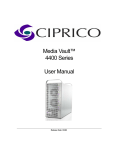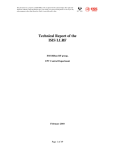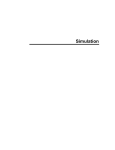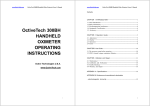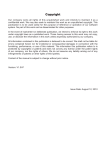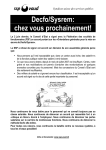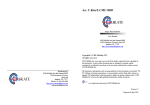Download VPOD Handheld Manual White / Blue Model
Transcript
The VirtuOx Total Solution No cost software + low cost oximeters = The industry’s most cost effective way to qualify oxygen patients! VPOD-H, a VirtuOx Pulse Oximetry Device VirtuOx, Inc, is also a nationwide Medicare approved Independent Diagnostic Testing Facility. “The VirtuOx Total Solution” consists of our flagship Overnight Oximetry Testing platform VirtuOxTM now at NO CHARGE, combined with our new, FDA approved VirtuOx compatible Pulse Oximeter Devices called VirtuOx VPODs. The VPOD line consists of both handheld and wrist worn Oximeters that can store up to 72 hours of recorded memory. By combining a NO CHARGE software with inexpensive hardware “The VirtuOx Total Solution” is the industry’s most cost effective way to qualify oxygen patients. VPOD-H Product Features: • FDA Approved • Data storage and transmission to VirtuOx VirtuOxTM is the latest generation of CMS approved Overnight Oximetry Testing software. It is designed to be an easy to use, trouble free software application available to all HME providers. There is no software to download or purchase and no contracts to sign. Best of all, the report is available quickly provided you have fulfilled CMS guidelines as a predicate to obtaining the report. VirtuOxTM is compatible with the VPOD-Wrist, VPOD-Handheld, 920M, 920M Plus, 8500, 2500A and Wrist Ox pulse oximeters. Laboratory for Oxygen Qualification • Data storage and transmission to VirtuOx O.E. Office Edition for Non Qualification Data Transmission to VirtuOx • USB interface for data transfer • 72 hours of data storage • Records at 1 second intervals • Three display modes Adult, Pediatric and Neonatal patients • Special design for sleep monitoring SpO2 • LCD Displays SpO2, SpO2 waveform & Pulse Rate • Low power consumption, uses 2 AAA battery • Battery low indicator • 3 year warranty Technical Specifications The VirtuOx Total Solution No cost software + low cost oximeters = The industry’s most cost effective way to qualify oxygen patients! PATIENT RANGE Measurement range Resolution Accuracy HEART (PULSE) RATE Range Resolution Accuracy Voice DISPLAY Type Parameters Mode Brightness STORAGE Patient ID Data records ENVIRONMENTAL VPOD-H $219 with FREE Software! Operating Temperature Storage Temperature Operating Humidity Storage Humidity BATTERY Type Operation time CLASSIFICATION Type of protection Safety MECHANICAL Dimensions Weight Click here to get yours NOW! Call Toll-Free 877-337-7111 • https://www.virtuox.net 0%-99% 1% +2% 80%-99%: +3% 70%-80%: 0%-69%:unspecified 0-254 bpm 1bpm +2bpm or +2% PR tone modulation LCD SpO2, PR, Waveform, Bargraph Three display modes Adjustable 10 levels 10 patients up to 72 hours 0°C-50°C -10°C - 60°C 15%RH - 95%RH 10%RH - 95%RH 2AA alkaline or rechargeable batteries About 24 hours for normal operation Internally powered equipment IEC 60601-1 130 x 40 27 mm 120g (including battery) Call Toll-Free 877-337-7111 Call Toll-Free 877-337-7111 • https://www.virtuox.net View Summary and Detail Oximetry Reports Manage Business with Dashboards Ver1.2 VPOD OPERATOR'S MANUAL CONTENTS CHAPTER 1 INTRODUCTION...................................1 1.1 BRIEF INTRODUCTION ........................................................................................... 1 1.3 ELECTROMAGNETIC COMPATIBILITY.................................................................. 2 1.4 EQUIPMENT CLASSIFICATION .............................................................................. 2 2.1 OUTER VIEW ............................................................................................................ 2 2.2 INSTALL THE BATTERIES ...................................................................................... 3 2.4 MONITORING ........................................................................................................... 3 2.5 FACTORS THAT MAY AFFECT THE MEASUREMENT .......................................... 3 3.1 DISPLAY ................................................................................................................... 4 3.2 MODE INTRODUCTION ........................................................................................... 4 3.3 KEY FUNCTIONS ..................................................................................................... 4 3.4 DATA REPLAY AND TRANSMISSION..................................................................... 5 CHAPTER 4 MAINTAINANCE AND REPAIR............5 4.1 MAINTENANCE ........................................................................................................ 5 4.2 TROUBLESHOOTING .............................................................................................. 5 4.3 WARRANTY AND REPAIR ....................................................................................... 6 APPENDIX A SPECIFICATIONS.............................7 APPENDIX B ..............................................................7 CHAPTER 1 INTRODUCTION 1.1 Brief Introduction Thank you for purchasing the handheld pulse oximeter for SpO2 and Pulse Rate (PR) measurement. The pulse oximeter features PR tone modulation, data storage and data transmission capabilities. Please read the operator's manual carefully before using this instrument. Intended use: The purpose and function of the handheld pulse oximeter is to indicate measure and display the functional oxygen saturation of arterial hemoglobin (SpO2) and pulse rate for adults and pediatric patients in hospital, ambulatory, home, and EMS (emergency medical service) environments. The pulse oximeter is intended for spot-checking these levels and not indicated for continuous monitoring. It can assist the clinician diagnostically by quickly displaying the patient’s %SpO2 and pulse rate and can additionally store 72 hours of data. Measurement principle The principle of pulse oximetry is based on the red and infrared (IR) light absorption of oxygenated and deoxygenated hemoglobin present in the circulating blood. Oxygenated hemoglobin absorbs more IR and allows more red light to pass through. Deoxygenated hemoglobin conversely absorbs more red light and allows IR light to pass through. The detector probe is placed on the finger. The probe contains two light emitting diodes (LED’s), one in the visible red spectrum (660nm) and one in the IR spectrum (940 nm). The beams of light from this probe pass through the tissues and some light is absorbed by the blood and soft tissues depending on hemoglobin concentration. The amount of light absorption at each light frequency is dependent on the degree of oxygenation of hemoglobin within the tissues. The microprocessor can select out the absorbance of the pulsatile fraction of blood, i.e. that due to arterial blood, from constant absorbance due to non-pulsatile venous or capillary blood and other tissue pigments Principal of Operation 1. Red and Infrared-ray Emitter Diode 2. Red and Infrared-ray Receptor Diode 1.2 Safety Information Warning, Precaution and Notice Warning, Precaution and Notice in the manual are special information that prompts the operator’s attention. Warning - Information concerning something that could possibly hurt the patient or operator. Precaution - Reminds the user to pay close attention to device operation, failure of which may cause abnormal function of the instrument. Notice - Informs the user of other important information by suggestion, requirement and supplement. Warning Please read this manual carefully before using this device. The user must check that the equipment functions safely and ensure that it is in proper working condition before being used. Do not use the pulse oximeter in an explosive atmosphere. Do not use the pulse oximeter in an MRI or CT environment The pulse oximeter is indicted for use by medical professionals only The device has no SpO2 alarms or PR alarms, it is not for continuous monitoring, as indicated by the symbol. Prolonged use of the probe/sensor or the patient’s condition may require changing the sensor site periodically. Change the sensor site and check skin integrity, circulatory status, and correct alignment at least every 4 hours. Prolonged use may cause blisters, skin deterioration, and discomfort. When connecting this monitor to any instrument, verify proper operation before clinical use. Refer to the instrument’s user manual for full instructions. The equipment connected to the pulse oximeter’s data interface must be certified according to the respective IEC standards, i.e., IEC950 for data processing equipment or IEC 601-1 for medical electrical equipment. All combinations of equipment must be in compliance with IEC601-1-1 systems requirements. 1 Ver1.2 VPOD OPERATOR'S MANUAL Sensor malfunction may cause inaccurate data possibly resulting in patient injury or death, so pay close attention to the sensor and inspect it often. Worn-out data cables may also cause inaccurate data, so if the data is used as a reference to treat a patient, pay special attention to data cable and check it more frequently. Do not tangle the SpO2 cable with the wires of ES (Electrosurgery) equipment. Single use accessories should never be reused. Precautions Autoclaving, ethylene oxide sterilizing, or immersing the sensors in liquid may cause inaccurate readings. The operator must be thoroughly familiar with the information in this manual before using the device. Unplug the sensor from the monitor before cleaning or disinfecting it. If liquid is accidentally spilled on the unit, clean and dry thoroughly before reuse. Do not try to use the SpO2 and NIBP measurement on the same arm at the same time. This could potentially affect measurement accuracy. Notices Operation of this device in an electromagnetic field may influence its accuracy. SpO2 measurements may be influenced by high ambient light, especially sunlight. Shield the sensor area as necessary. Dyes introduced into the bloodstream, such as methylene blue, indocyanine green, indigo carmine, and fluorescein, may influence the accuracy of the SpO2 reading. Any condition that restricts blood flow, such as use of a blood pressure cuff or extremes in systemic vascular resistance, may cause a failure to determine accurate pulse rate and SpO2 readings. Remove fingernail polish or artificial fingernails before applying SpO2 sensors. Fingernail polish or artificial fingernails may cause inaccurate SpO2 readings. Optical cross-talk can occur when two or more sensors are located in adjoining areas. It can be eliminated by covering each site with opaque material. Optical cross-talk may adversely affect the accuracy of the SpO2 readings. Obstructions or dirt on the sensor’s red light or detector may cause a sensor failure. Make sure there are no obstructions and the sensor is clean. For routine equipment maintenance, please refer to the service procedures at the associated section as indicated in the manual. As to the other concerns for attention, please carefully look through the specific chapter in this instruction. 1.3 Electromagnetic Compatibility This oximeter is designed and tested in compliance with the EMC standard, complying with the international standard for the EMC of the medical electrical device - IEC 60601-1-2. However, because of the proliferation of radio frequency transmitting equipment and other sources of electrical noise in the health-care and home environments (e.g. cellular phones, mobile two-way radios, electrical appliances) it is possible that high levels of such interference due to close proximity or strength of a source, may result in disruption of performance of this device. This apparatus complies with the IEC 60601-1-2 international standard. The requirements of this international standard are: CISPR11, GROP1, and CLASS B. 1.4 Equipment classification 1.5 Accessory Standard accessories: Operator’s manual VPROBE V_SOFT Finger sensor: compatible with The VPOD Two AA-Size Alkaline batteries Subscription to Virtuox Optional accessories: 1. Finger sensor for pediatric and infant: compatible with BCI (Pediatric 15-45 Kg, Infant 3-15 Kg) 2. Finger sensor for neonate: compatible with BCI (Neonate<3kg) 3. Software license 5. Data cable for transmission to Virtuox 6. 2 year extended warranty Confirm that the items listed are packed with the pulse oximeter. If any item on this list is missing or damaged, contact your distributor. Contact the carrier immediately if the shipping carton is damaged. CHAPTER 2 BASIC OPERATION 2.1 Outer View Figure2.1 Front view 2 Ver1.2 VPOD OPERATOR'S MANUAL Figure 2.2 rear view 2.2 Install the batteries The oximeter can be powered by 2 AA-Size alkaline batteries (which will typically provide 50 hours of continuous operation), or by the optional rechargeable NiMH battery pack. When battery power is lower than 2.4V, the sign figure 2.3. will flicker in its display area. Replace the battery (or rechargeable NiMH battery pack) as soon as possible. The installation steps are shown as Be sure to insert the batteries in the correct polarity, as indicated by polarity marking (+ and -) inside the battery compartment. Figure 2.3 2.3 Connect the sensor Connect the oximeter sensor to the top of the oximeter as shown in figure 2.4. Ensure that the sensor is firmly plugged in. Figure2.4 2.4 Monitoring Clip the sensor to the patient’s finger, and ensure that the patient’s nail surface is facing upward, as shown in figure 2.5. Fig2.5 Placement of the finger 2.4.1 Power on the oximeter Press the function key (left key) to power it on. Several seconds later, the measurement value will appear. Notice: To maintain the highest degree of accuracy, it is recommended that the finger and the oximeter sensor/probe is kept as still as possible. 2.4.2 Brightness adjustment When you press the function key (left key) for more than one second, the brightness level headed with “Br” will be shown on the top right of the screen. You can adjust the brightness by degrees by pressing the setting key (right key). There are 10 levels of brightness. The default is level four. Figure 2.6 2.4.3 Mode switch After turning on the oximeter, each time the function key (left key) is pressed, the oximeter will switch to another display mode, shown as Figure 3.1. 2.5 Factors that may affect the measurement During operation, the accuracy of oximetry readings can be affected by the following factors: 2.5.1 Instrument performance depends on the pulsatile character of the artery. The measurement would not be considered reliable and accurate if the following conditions are present during measurement. Shock or cardiac arrest Temperature of the digit After the administration of a cardiovascular drug Anemia Evidence of ventilation-perfusion mismatch 2.5.2 Instrument performance depends on the wavelength absorption for oxyhemoglobin and deoxyhemoglobin. If there are substances absorbing the same wavelength, this would induce false or low SpO2 values. The following may affect these values: carboxyhemoglobin methemoglobin methylene blue Indigo carmine 3 VPOD OPERATOR'S MANUAL Ver1.2 2.5.3 Extremely high illumination could affect the SpO2 measurement. Use a semi-translucent or opaque cover to shield the sensor. 2.5.4 Other factors a) High-frequency electrosurgical interference from external devices, including defibrillators. b) Placement of a sensor on an extremity that currently has installed a blood pressure cuff, arterial catheter, or intravascular line; c) The patient has hypotension, severe vasoconstriction, severe anemia, or hypothermia; d) An arterial occlusion proximal to the sensor. Warning Use only SpO2 sensors provided by manufacturer. Other SpO2 sensors may cause improper performance. Do not use an SpO2 sensor with exposed optical components. Excessive patient movement may cause inaccurate measurements. Tissue damage can be caused by incorrect operation or misusing sensor; for example, by wrapping the sensor too tight. Inspect the sensor site to ensure the skin’s integrity and the adhesion position of the sensor is correct. More frequent inspection should be taken if necessary. Loss of pulse signal can occur in any of the following situations: a) The sensor is too tight; b) There is excessive illumination from light sources such as a surgical lamp, a bilirubin lamp, or sunlight; c) A blood pressure cuff is inflated on the same extremity as the one to which an SpO2 sensor is attached. CHAPTER 3 DETAILED OPERATION 3.1 Display The handheld pulse oximeter uses an LCD display for readout. It can display the SpO2 and pulse rate (PR) value, as well as a pulse column and SpO2 waveform. There are three display modes shown in Fig 3.1. The first figure is pulse column display mode. The second figure is filled waveform mode. The third figure is line waveform mode indicating SpO2% trend. (1) (2) (3) Fig 3.1 Three display modes SpO2: Percent oxygen saturation value displayed above is 98% PR: Pulse rate value displayed is 72 bpm Pulse column: This is used for signal identification and quality indication during motion and low signal to noise situations. The bar rises and falls with the pulse, its height indicating signal quality. When the bar is very low, the SpO2 and pulse rate values may be suspect. Signal strength: Indicates arterial pulse signal strength and may be used as a diagnostic tool during low perfusion for the accurate prediction of illness severity. The bar is highest when the quality of the perfusion state is best and low when the perfusion is poor. PR tone modulation: Beeps in sync with the patient’s pulse, even under most challenging patient motion conditions. 3.2 Mode Introduction Power On - Measurement and operation can be done normally. There are three display modes: “Measure mode”, “Information display mode” and “Trouble display mode”. 1) Display modes “Measure mode”: the sensor is plugged in correctly, and the finger is properly in the sensor, the oximeter is in the measurement mode for both SpO2 and PR. “Information display mode”: The sensor is not plugged into the oximeter or the sensor is plugged in the oximeter but the finger is not in the sensor, “Probe off” or “Finger off” will be displayed respectively, and it will automatically power Off if either information display lasts for more than 8 seconds. “Trouble display mode”: In the failure state, the oximeter will display error information, and will automatically power Off if the information display lasts for more than 8 seconds. For error information details and definitions, please refer to chapter 4.2. 2) Definition of key There are two keys in the oximeter: “Function key (left key)” and “Setting key (right key)”. “Function Key”: Located at the left of the oximeter, this acts as a Power On switch when the unit is in an Off condition. When the unit is On, it acts as a Function key “Setting key”: Located at the right of the oximeter, it has no function when the power is off. When the unit is On, it acts as a Setting key. 3) Definition of Key Press There are three ways to press the key: Press: press the key quickly, the duration time should no more than 1 second. Double press: Two-time continuous press, the time between the two press actions should be no more than 0.5 second. Extended press: Press the key for more than 1.5 seconds. 3.3 Key Functions 1) Power On/Off Press the Function key (left key) to power on. The oximeter will power off automatically under the “information display mode” or “trouble mode” for 8 seconds. 2) The Display Mode setting can only be enabled under “Measure mode” and “Information Display mode”. Pressing the Function key (left key) or Setting key (right key), the display mode may be changed sequentially between “Filled Waveform”, “Line Waveform” and “Pulse Column Waveform”. Once you choose a certain mode, the oximeter will continually display in this mode until changed by the user. 3) Setting Mode Entering or exiting the Setting Mode can be done only under the “information display mode”. You can set Brightness, Patient ID, Date and Time under the “Setting Mode”. Current parameters and data will be displayed at the top right corner which is used to display the “PR”. The various parameters display title is as follows: Br – Brightness (range:1-10) ID - Patient ID (range:1-10) Y – Year (range:0-99) M - Month (range:1-12) D – Day (range:1-31) H – Hour (range:0-23) M - Minute, (range:0-59) S – Second (range:0-59) a) Enter “Setting mode” 4 VPOD OPERATOR'S MANUAL Ver1.2 Under the “Information Display mode”, press the function key (left key) for more than one second (extended press), the oximeter will enter into “Setting mode” and you will find a parameter item which include its title and value on the top right corner of the display. Under the setting mode, continually press “Function key (left key)”, the current parameter item will be changed sequentially in the following order: Br(brightness)-->ID(patientID)-->Y(year)-->M(month)-->D(date)-->H(hour)-->m(minute)-->S(second)--Br(brightness)-->... Notice: When setting, please don’t insert finger. b) Save and exit from “Setting mode” ①Under the “Setting mode”, press “function key (left key)” to select the desired parameter item. ②Then press “Setting key (right key)” to adjust the value. Each time when you press the “Setting key (right key)”, current parameter value will be added by 1 unit sequentially. Double press the “Setting key (right key)” and the current parameter setting will be added by 10 units sequentially. All use circular logic. ③ To finish one setup, press both left and right keys together to confirm. Then the modification under the “Setting mode” will be saved, at the same time, the system will exit from “Setting mode”. Notice: ① to ③ to finish every setup. Each time only can set one parameter item, you must redo the step The parameters adjustment only can be done in the “Setting mode” under “Information Display mode”. c) Cancel and exit from “Setting mode” Under the “Setting mode”, double-press the Function key (left key), the modification under “Setting mode” will be cancelled and simultaneously, the system will exit from “Setting mode”. If there is no operation under “Setting mode” for more than 10 seconds, the system will exit from “Setting mode” automatically. 3.4 Data replay and transmission The oximeter can record SpO2 and PR value for more than 24 hours, and can analyze records one by one. You can transmit the history data to a PC using “Virtuox” software and a special data cable. As for detailed setup and operation, please refer to the “Virtuox” website. www.virtuox.net Note: Virtuox can be obtained at no charge with the purchase of this device. Please contact Virtuox customer service to set up an account. 877-337-7111 CHAPTER 4 Maintenance and Repair 4.1 Maintenance It is very important for user to perform daily maintenance of oximeter and parts in order to maintain its function and appearance. Disinfection procedures may be performed with the use of the below mentioned cleaner/disinfectants. Failure to perform these procedures may result in invalidating the warranty. Local disinfection protocols will apply. Please take out battery before cleaning the oximeter. The external surface of the oximeter can be cleaned by wiping with a damp cloth. Do not submerge the oximeter in any solution at any time. To do so will void the warranty Use the following permitted solutions: Ammonia (diluted) Glutaraldehyde 10% Bleach solution Mild soapy water (diluted). Do not use the following cleaners: ○ Any kind of scrubbing or scouring solution ○ Acetone ○Alcohol-based cleaners Battery maintenance Remove the batteries if you will not be using the oximeter for an extended time. Charge the batteries (NiMH or Li) fully prior to storage. Please charge over 14 hours at first time, or will reduce the battery life. 4.2 Troubleshooting a) Error Definitions Err 1: program memory damaged. Err 2: data memory damaged. Err 3: sensor Red Emission Diode damaged. Err 4: sensor Infrared-ray Emission Diode damaged. Err 5: sensor Infrared-ray Receipt Diode damaged. Err 6: exterior crystal oscillator damaged. Err 7: sensor emission diode or receipt diode damaged. Err 9: real time clock damaged. Err 10: EEPROM chip damaged. b) Possible problem and corresponding resolution Problems Possible reason SpO2 or PR 1. Finger is not plugged 1. Retry by plugging the finger cannot be correctly 2. Attempt several time to obtain a displayed 2. Patient’s Oxyhemoglobin normally Solution reading, If are sure that no value is too low to be problem exists, obtain further measured clinical examination 5 VPOD OPERATOR'S MANUAL Ver1.2 SpO2 or PR display is unstable 1. Finger might not be plugged deep enough 1. Retry by plugging the finger 2. Urge the patient to remain still 2. Finger is trembling or patient is moving continually The Oximeter 1. Battery power may be inadequate or not installed can not be 2. Batteries might be powered on installed incorrectly 3. The Oximeter might be damaged “Error3” 1. Receiving diode may be or shielded or damaged “Error4” together with broken Displayed connector. on screen 2. Mechanical Misplace for receive-emission diode 1. Please replace batteries 2. Please reinstall the batteries 3.Contact local customer Technical Service 1.Contact local customer Technical Service 2.Contact local customer Technical Service 3.Contact local customer Technical Service 3. Amp circuit malfunction. “Error7” 1. Emission diode damaged. displayed 2. Current control circuit on screen malfunction. 1 Contact local customer Technical Service 2 Contact local customer Technical Service “Probe off” 1. The sensor is not 1.Connect the sensor displayed connected 2. Please check if the probe was on screen 2 The connection between connected with oximeter correctly the Probe and Oximeter is loose 4.3 Warranty and Repair 4.3.1 Service Method a Service hours: 9:00am 5:30pm, Monday - Friday b Service support: Telephone and e-mail support. ) ) ~ Parts Replacement: Virtuox will replace parts if necessary free of charge during the warranty period. 4.3.2 Exemptions and limitations: a) Not responsible for damage caused by force majeure. For example: fire, lightning, flood, cyclone, hail and earthquake. b) Warranty expiration. The corresponding cost of insurance, disassembling, refurbishing, repackaging and shipping the oximeter or its components c) Damage caused by a third party d) Damage and caused by user or its representative not in compliance with the operator’s manual. e) The oximeter is installed or connected with such external device without our company permission as printer, computer, netline and lead to oximeter failure. Our company will charge for the maintenance. d) Warranty Limitation Warranty is void if parts made from other manufacturers are used in the servicing of the device. 4.3.3 User Guarantee a) User must read user manual carefully before operation. b) User must operate and perform daily maintenance under manual specifications. c) Power supply and environment must be maintained under manual specifications. 4.3.4 Circumstances that may void the warranty The device does not remain in original condition. ●The shell of the device is breached or cracked. ●Evidence of water damage. ●Accessories adulterated or appearance of physical abuse. ●Evidence of crushing damage to the probe. ●Original Packaging during transportation is not used. ●Non authorized service is performed on oximeter. ●Damage to a product as a result of not conforming to manual specifications. 4.3.5 User’s Special Request for Extended Warranty Our warranty is consistent with industry standards. The device and accessories come standard with a 1 year warranty. An extended warranty can be purchased from Virtuox at the user’s request. Return Policy: Warranty and non warranty returns should be handled in the following manner: Contact the Technical Support Department and obtain a RMA (Return Materials Authorization) number. The RMA number must appear on the outside of the shipping container. Return shipments will not be accepted if the RMA number is not clearly visible. Please provide the model number, serial number (SN), and a brief description of the reason for return. Freight policy: 1. Within Warranty: The customer is responsible for freight & insurance charges when the equipment is shipped to Virtuox for service. Virtuox is responsible for the freight & insurance charges from us to the customer. 2. After Warranty: The customer is responsible for any freight & insurance charges for returned product. 6 VPOD OPERATOR'S MANUAL Ver1.2 4.3.6 Repackaging for returns ●Place all accessories in a watertight Ziploc bag ●Use original package and packing material if possible. User will be responsible for damage caused by improper packaging during transportation. ●Ensure the RMA number is clearly printed on the Box. ●Include an insert describing the reason for the return.. APPENDIX A Specifications SpO2 Range: 0%-99% Resolution: 1% Accuracy: 80%-99%: ±2% 70%-80%: ±3% 0%-69%: unspecified Data update time: < 15 s Measurement Wavelengths and Output Power Red 660nm @ 3mw nominal Infrared 940nm @3mw nominal Heart (Pulse) Rate Range: 30-254 bpm Resolution: 1bpm Accuracy: ±2bpm or ±2% Alarm Alarm: Probe off, Finger out, Low battery Modes: Visual Information Display Type: OLED, double color Parameters: SpO2, PR, Pleth waveform, Pleth bar Mode: 3 display modes. Record Patient ID Data record 10 patients Up to 72 hours Data transmission Transmission method: Cable Transmission Data Cable Interface: DB9 (Connect to Pulse Oximeter) DB9 USB (Connect to PC) USB Environmental Operating Temperature: 5-40°C Storage Temperature: -20 to +70°C Operating Humidity: 15%RH - 95%RH Storage Humidity: 10%RH - 95%RH Classification per IEC60601-1 Type of protection: Internally powered equipment Degree of protection: Type B-Applied Part Mode of Operation: Continuous Safety: IEC Standard 60601-1 Dimensions: 110 x 35 x 27 mm Weight: 110g (with alkaline batteries) Power Type Operation time 2 AA Alkaline or Rechargeable batteries About 50 hours of typical operation APPENDIX B 7 VPOD OPERATOR'S MANUAL Ver1.2 Guidance and manufacture's declaration - electromagnetic immunity The Handheld Pulse Oximeter is intended for use in an electromagnetic environment specified below. The customer or the user of the Pulse Oximeter should assure that it is used in such an environment. Immunity IEC Compliance Test 60601 Level Electromagnetic environment guidance Test level Electrostatic 6kV 6kV Floors should be wood, concrete or Discharge contact contact ceramic tile. If floor are converted with (ESD) 8kV air 8kV air Synthetic material, the relative humidity IEC610004-2 should be at least 30% Guidance and manufacture's declaration - Electromagnetic Immunity for Equipment and Systems that are not Life-Supporting d= 61000-4-6 d= 3.5 V 3.51 E1 P 80MHz to 800MHz P 800MHz to 2.5GHz 3V/m Where P is the maximum output power rating of the transmitter in Watts (W) according to Radiated 80Hz the transmitter manufacture and d is the recommended separation distance in meters RF IEC to 2.5 GHz 61000-4-3 (m). Field strengths from fixed RF transmitters, as determined by an electromagnetic site survey, should be less than the compliance level in each frequency range. Inter ference may occur in the vicinity of equipment marked with the following symbol. NOTE1 At 80MHz and 800MHz, the higher frequency range applies. NOTE2 These guideline may not apply in all situations. Electromagnetic propagation is affected by absorption and reflection from structures, objects and people. a Field strengths from fixed transmitters, such as base situation for radio (cellular/cordless) telephones and land mobile radios, amateur radio, AM and FM radio broadcast and TV broadcast cannot be predicted theoretically with accuracy. To assess the electromagnetic environment due to fixed RF transmitters, an electromagnetic site survey should be considered. If the measured field strength in the location in which the Handheld Pulse Oximeter is used exceeds the applicable RF compliance level above, the Handheld Pulse Oximeter should be observed. Recommended separation distances between portable and mobile RF communications equipment and the Handheld Pulse Oximeter The Handheld Pulse Oximeter is intended for use in an electromagnetic environment in which radiated RF disturbance are controlled. The customer or the user of the Handheld Pulse Oximeter can help prevent electromagnetic interference by maintaining a minimum distance between portable and mobile RF communication equipment ( transmitters) and the Handheld Pulse Oximeter as recommended below, according to the maximum output power of the communications equipment. Separation distance according to frequency of transmitter (m) 150KHz to 80 MHz 3.5 d= V1 P 80MHz to 800 800MHz to 2.5 GHz MHz d= 3.5 d= E1 P 7 E1 P Rated maximu m output power of transmitt er (W) 0.01 0.1167 0.1167 0.2334 0.1 0.3689 0.3689 0.7378 1 1.1667 1.1667 2.3334 10 3.6893 3.6893 7.7386 100 11.6667 11.6667 23.3334 For transmitters rated at a maximum output power not listed above, the recommended separation distance in meters (m) can be estimated using the equation applicable to the frequency of the transmitter, where P is the maximum output power rating of the transmitter in watts (W) according to the transmitter manufacturer. NOTE1 At 80MHz and 800MHz, the separation distance for the higher frequency range applies. NOTE2 These guidelines may not apply in all situations. Electromagnetic interference is affected by absorption and reflection from structures, 8 Ver1.2 VPOD OPERATOR'S MANUAL objects and people. 9












